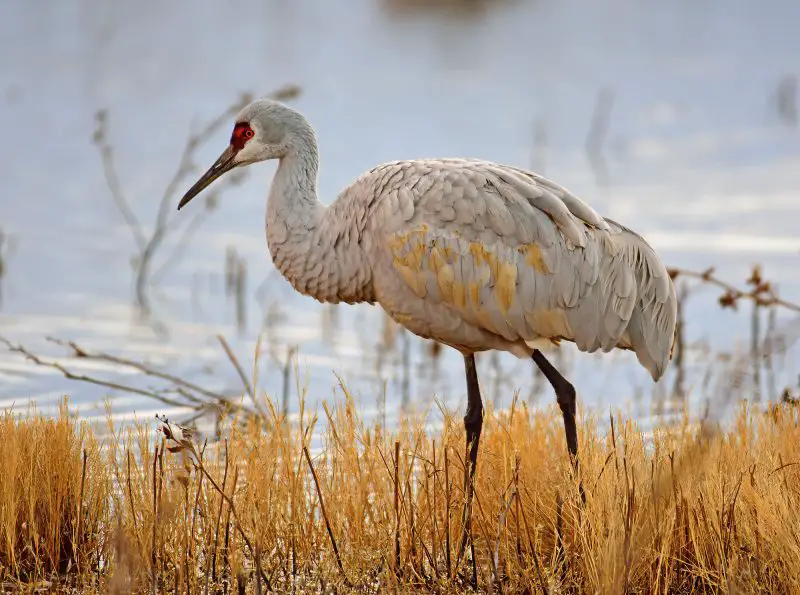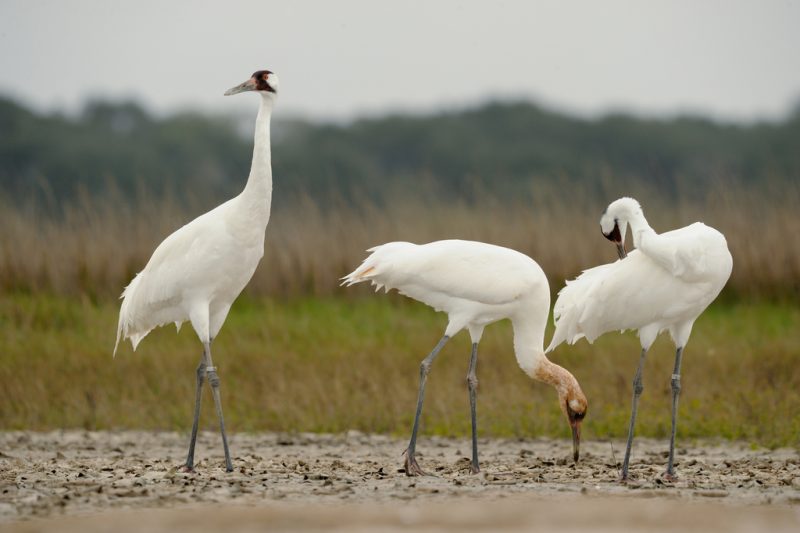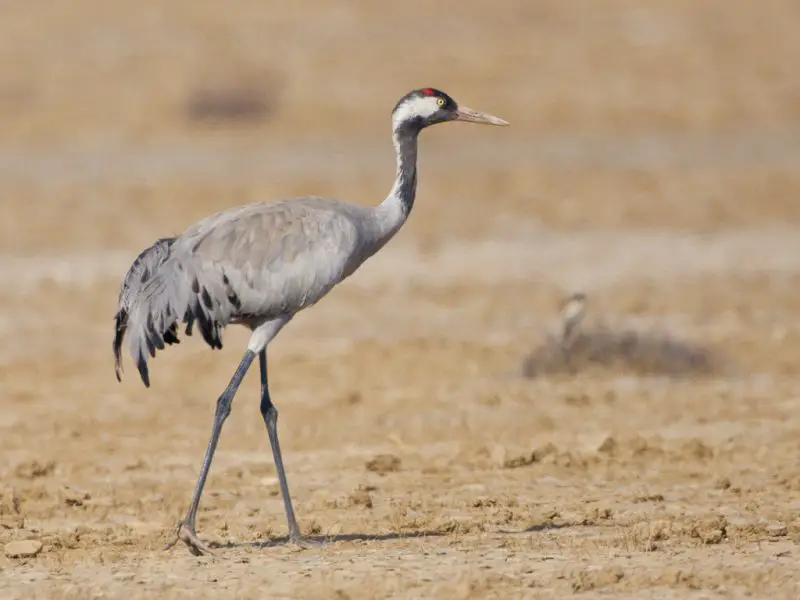Nebraska, with its expansive prairies and wetlands, serves as a pivotal stopover for migratory birds, particularly cranes. Among the crane species observed in the state, three stand out due to their distinctive characteristics and behaviors.
This article delves into the Sandhill Crane, the Whooping Crane, and the Common Crane, highlighting their identification features, habitats, diets, reproductive habits, and intriguing facts.
Sandhill Crane (Antigone canadensis)

Identification and Size
The Sandhill Crane is a strikingly large bird, typically standing between 3.5 to 4 feet tall. Its wingspan is impressive, ranging from 6.5 to 7.5 feet, which allows for graceful and powerful flight. The plumage is primarily gray, with some birds displaying subtle rusty or brownish tones, depending on their age and molting stage. A prominent red crown adorns the forehead, making it easily recognizable in the field.
Unlike the Whooping Crane, the Sandhill Crane does not have a fully white body, which helps birdwatchers quickly distinguish between these two species. Its long legs and neck add to its elegant silhouette, particularly visible when foraging or in flight.
Behavior and Habitat
Sandhill Cranes are renowned for their intricate and energetic courtship dances. These displays include coordinated jumping, bowing, wing-flapping, and loud calling, often performed by both males and females. These behaviors are not only for mating but also reinforce pair bonds and social interactions within groups. In Nebraska, the Platte River Valley serves as a crucial stopover during migration. Thousands of cranes gather here in late winter and early spring to rest, feed, and gain energy before continuing their journey to northern breeding grounds. The valley’s shallow wetlands, surrounding grasslands, and agricultural fields provide essential food and protection from predators, making it one of the most important staging areas for this species in North America.
Diet
The Sandhill Crane has a versatile, omnivorous diet that shifts with seasonal availability. Plant matter constitutes a significant portion of their intake, including grains, seeds, roots, and tubers. During the warmer months, they also hunt small animals, such as insects, amphibians, and small mammals, which provide protein to fuel their energy-intensive activities like migration and mating displays. Their adaptability in diet allows them to thrive across various habitats, from wetlands to grasslands and even agricultural fields.
Reproduction
Sandhill Cranes are monogamous, typically forming lifelong pairs. Mating usually occurs during spring migration, although some cranes begin pair formation as early as two years old. Nesting takes place in wetlands or marshy areas, where the pair constructs a mound of vegetation and grasses to form a shallow nest. They usually lay one to three eggs, which both parents incubate for around 28–30 days.
The chicks are precocial, emerging from the nest with their eyes open and capable of walking and following their parents shortly after hatching. This early mobility is vital for survival in the wetland environment, helping chicks evade predators and forage alongside adults.
Fun Fact
The Sandhill Crane is easily recognizable by its distinctive call—a loud, rattling “kar-r-r-o-o-o” sound that carries over long distances. This call serves multiple purposes: maintaining pair bonds, coordinating with flock members during migration, and signaling alarm. Observers often describe hearing the call echoing across the Platte River Valley, creating one of nature’s most iconic avian soundscapes during migration season.
Whooping Crane (Grus americana)

Identification and Size
The Whooping Crane is the tallest bird in North America, standing at about 5 feet tall and weighing around 15 pounds. Despite its impressive height, it has a slender and elegant build, supported by hollow bones that make it lighter and more agile in flight. Its plumage is primarily pure white, creating a striking contrast with the black wingtips that become visible during flight. A vivid red crown adorns the top of its head, adding to its distinctive appearance.
These cranes are easily recognizable even from a distance due to their size and coloration. Their long, thin necks and legs emphasize their graceful stature, while their wingspan, which can exceed 7 feet, aids in long migratory flights across North America.
Behavior and Habitat
Whooping Cranes are renowned for their elaborate courtship dances, which involve synchronized movements, bows, leaps, and loud calls. These displays are not only captivating to observe but also play a crucial role in pair bonding.
During migration, Whooping Cranes inhabit marshes, wetlands, mudflats, and wet prairies. In Nebraska, they are rare visitors, usually stopping briefly as they travel between breeding and wintering grounds. Their preference for remote, undisturbed habitats ensures safety from predators and minimal human disturbance.
Diet
Whooping Cranes are omnivorous and feed on a variety of small animals and plant matter. Their diet primarily includes crustaceans, small fish, insects, amphibians, and reptiles. They use their long legs to wade through shallow waters and their sharp bills to probe the mud and water for prey. This foraging technique allows them to access food sources that many other birds cannot reach.
Reproduction
Whooping Cranes are monogamous and often return to the same breeding sites each year. Nesting typically occurs in secluded wetlands, where they build their nests on floating vegetation or shallow water areas to reduce the risk of predation. The female usually lays one or two eggs, and both parents take turns incubating them.
The chicks are precocial, meaning they are relatively mature and mobile shortly after hatching. Both parents guide and protect them, teaching essential survival skills until the young are capable of foraging independently.
Fun Fact
The Whooping Crane gets its name from its distinctive “whooping” call, a loud and far-reaching sound that can travel several miles. This call is especially prominent during migration and is used for communication between mates and family groups.
Common Crane (Grus grus)

Identification and Size
The Common Crane is a large and elegant bird, standing approximately 3.5 feet tall with a wingspan reaching around 6.5 feet. Its plumage is mainly gray, complemented by a striking black crown and a prominent white patch on the back of its neck. These color patterns make it easily identifiable in the wild.
In flight, the Common Crane exhibits a distinctive posture: its long legs stretch beyond the tail, and the neck remains straight, setting it apart from other crane species. Its slender build and long wings allow it to cover vast distances during migration efficiently.
Behavior and Habitat
Common Cranes are celebrated for their elaborate courtship dances, which involve bowing, jumping, wing flapping, and synchronized calls. These rituals are important for pair bonding and are a spectacular sight during the breeding season.
These cranes inhabit wetlands, grasslands, and agricultural fields, often preferring open landscapes where they can easily forage and watch for predators. In Nebraska, they are considered rare visitors, usually pausing briefly as they travel along migratory routes from their northern breeding grounds to southern wintering areas.
Diet
The Common Crane has an omnivorous diet, feeding on grains, seeds, roots, and small invertebrates. They forage both in open fields and shallow wetlands, using their long bills to probe the soil and water for food. This adaptability in feeding allows them to thrive in a variety of habitats and during different seasons.
Reproduction
Common Cranes are monogamous and typically return to the same breeding sites each year. Nesting takes place in wetlands, where the birds construct mounds of vegetation to lay one or two eggs. Both parents actively share incubation duties, ensuring the eggs are protected and kept warm.
The chicks are precocial, hatching with their eyes open and capable of walking shortly after birth. Both parents guide and protect the young, teaching them to forage and navigate their environment until they are independent.
Fun Fact
The Common Crane is famous for its distinctive trumpeting call, which can carry over long distances. This resonant sound is especially noticeable during migration, helping pairs and family groups stay in contact across expansive wetlands and fields.
Best Time and Places to See Cranes in Nebraska
Nebraska is renowned for one of the most spectacular wildlife events in North America: the spring migration of cranes. The best time to witness this natural spectacle is from late February through March, when thousands of Sandhill Cranes congregate in the Platte River Valley during their journey north. Peak viewing typically occurs in mid-March, although the exact timing can vary slightly each year depending on weather conditions.
The Platte River Valley is the premier destination for crane-watching in Nebraska. The wide, shallow river provides ideal feeding grounds for cranes, and the surrounding wetlands offer safe resting areas. Popular viewing sites include Rowe Sanctuary, which hosts guided tours and educational programs, and Crane Trust Nature & Visitor Center, where visitors can learn about crane conservation while observing these majestic birds. Other excellent locations include public lands and wildlife refuges along the central Platte River corridor.
For the most rewarding experience, arrive early in the morning or late in the afternoon, when cranes are most active, feeding in the fields or gathering for their evening roost. Pairing your visit with binoculars or a spotting scope will enhance your viewing and photography opportunities. Visiting during this peak migration season provides a chance to see tens of thousands of cranes, including Sandhill Cranes, whoopings, and occasionally other species, making Nebraska a must-see destination for bird enthusiasts.
Frequently Asked Questions About Cranes in Nebraska
What types of cranes can be seen in Nebraska?
Nebraska is home to three main crane species: the Sandhill Crane, Whooping Crane, and Common Crane. Sandhill Cranes are the most common and frequently seen during migration. Whooping and Common Cranes are rarer, usually stopping briefly during their migratory journey through the state.
When do cranes migrate through Nebraska?
Cranes typically migrate through Nebraska in the spring and fall. The peak viewing season for Sandhill Cranes is from late February to early April, especially in the Platte River Valley, which serves as a critical stopover during their migration.
Where do cranes in Nebraska gather?
Cranes prefer wetlands, river valleys, and surrounding grasslands. The Platte River Valley is a well-known hotspot for viewing large flocks of Sandhill Cranes. Whooping and Common Cranes also use wetlands and open fields as temporary stopovers during migration.
What do cranes eat in Nebraska?
Sandhill Cranes primarily feed on grains, seeds, and small invertebrates in agricultural fields and wetlands. Whooping Cranes forage for crustaceans, small fish, insects, amphibians, and reptiles in shallow waters. Common Cranes eat grains, seeds, roots, and small invertebrates, feeding in both fields and wetland areas.
How do cranes behave in Nebraska?
All three species are known for their striking courtship dances, which include bows, jumps, wing flaps, and calls. Sandhill Cranes are highly social and often gather in large groups, while Whooping and Common Cranes are more solitary or found in smaller family groups during migration.
Are cranes protected in Nebraska?
Yes. Whooping Cranes are endangered, and both Sandhill and Common Cranes are protected under state and federal laws. Conservation efforts focus on protecting migratory stopovers, wetlands, and breeding habitats to ensure these majestic birds continue to thrive in Nebraska.






